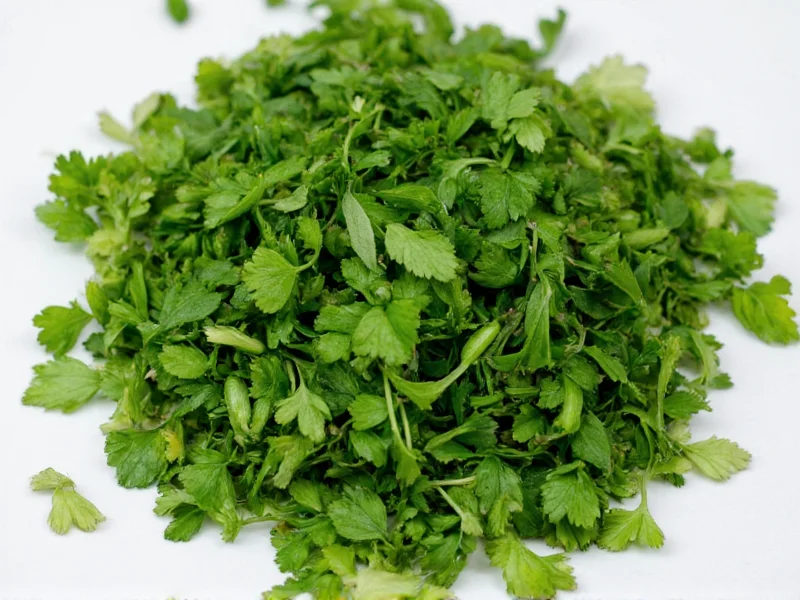1 tablespoon of fresh parsley equals 1 teaspoon of dried parsley. This 3:1 conversion ratio accounts for the moisture difference between fresh and dried herbs, with dried parsley being more concentrated in flavor and volume.
Understanding herb conversions is essential for consistent cooking results. When substituting dried parsley for fresh in recipes, you need to adjust measurements properly to maintain balanced flavors. The standard conversion—1 tablespoon fresh parsley to 1 teaspoon dried parsley—is based on the fundamental difference in moisture content and flavor concentration between these two forms of the same herb.
Why the 3:1 Conversion Ratio Works
Fresh parsley contains approximately 85-90% water, while dried parsley has most of this moisture removed through the drying process. This dehydration concentrates the herb's essential oils and flavor compounds, making dried parsley significantly more potent by volume.
When herbs lose their water content during drying, their flavor compounds become more concentrated. This is why you need less dried parsley to achieve a similar flavor impact as fresh. The 3:1 ratio (three parts fresh to one part dried) has been established through culinary testing as the most reliable conversion for parsley specifically.
Practical Application in Your Cooking
When following recipes that call for fresh parsley but you only have dried available (or vice versa), proper conversion ensures your dishes maintain the intended flavor profile. Consider these practical guidelines:
- For soups, stews, and long-cooking dishes: Dried parsley often works better as it has time to rehydrate and distribute flavor evenly
- For garnishes and fresh finishes: Always use fresh parsley for its brighter color and more delicate flavor
- When adjusting recipes: Start with slightly less dried parsley than the conversion suggests, then taste and adjust
Complete Herb Conversion Reference
| Herb | Fresh Measurement | Dried Measurement | Conversion Ratio |
|---|---|---|---|
| Parsley | 1 tablespoon | 1 teaspoon | 3:1 |
| Basil | 1 tablespoon | 1 teaspoon | 3:1 |
| Oregano | 1 tablespoon | 1.5 teaspoons | 2:1 |
| Thyme | 1 tablespoon | 1 teaspoon | 3:1 |
| Rosemary | 1 tablespoon | 1.5 teaspoons | 2:1 |
Maximizing Flavor with Proper Parsley Use
The timing of when you add parsley to your dishes significantly impacts the final flavor. For dried parsley, add it early in the cooking process to allow time for rehydration and flavor development. Fresh parsley should be added in the last few minutes of cooking or as a garnish to preserve its delicate flavor and vibrant color.
Storage methods also affect potency. Keep dried parsley in an airtight container away from light and heat, where it maintains peak flavor for 6-12 months. Fresh parsley lasts 1-2 weeks when stored properly in the refrigerator with stems in water and covered with a plastic bag.
Common Substitution Mistakes to Avoid
Many home cooks make these common errors when substituting fresh and dried parsley:
- Using equal measurements (1:1 ratio) instead of adjusting for concentration
- Adding dried parsley at the end of cooking, resulting in harsh, undeveloped flavor
- Using old, stale dried parsley that has lost its potency
- Not considering that dried parsley has a more earthy, less bright flavor profile
Remember that while the 1 tbsp fresh parsley to dried conversion provides a reliable starting point, your personal taste preferences and the specific dish you're preparing may require slight adjustments. Always taste as you cook and adjust seasoning accordingly.
Frequently Asked Questions
Can I substitute dried parsley for fresh in all recipes?
While you can substitute dried parsley for fresh in most cooked dishes, it's not recommended for garnishes or fresh applications. Dried parsley lacks the vibrant color and delicate flavor of fresh, making it unsuitable as a finishing touch. For soups, stews, and sauces where appearance matters less, the substitution works well using the 3:1 conversion ratio.
Why does dried parsley taste different from fresh even when properly converted?
The drying process changes parsley's chemical composition. Fresh parsley contains volatile compounds that provide bright, grassy notes which are partially lost during drying. Dried parsley develops more earthy, concentrated flavors. This flavor profile difference means that while measurements can be converted, the final dish will have subtle taste variations depending on which form you use.
How do I adjust recipes when using frozen parsley instead of fresh?
Frozen parsley behaves more like fresh than dried. When substituting frozen parsley for fresh, use a 1:1 ratio. Thaw frozen parsley before use and gently squeeze out excess moisture. For best results, add frozen parsley toward the end of cooking to preserve flavor, similar to fresh parsley.
Does the 1 tbsp fresh parsley to dried conversion work for all cooking methods?
The standard conversion works for most cooking methods, but requires slight adjustments based on technique. For quick-cooking dishes (like sautés), use slightly less dried parsley (about 3/4 teaspoon instead of 1 teaspoon) since it has less time to mellow. For slow-cooked dishes, the standard 1 teaspoon dried per 1 tablespoon fresh works perfectly as the flavor has time to integrate.
How can I tell if my dried parsley has lost potency?
Dried parsley that has lost potency will have faded color (from dark green to brownish), minimal aroma when crushed between fingers, and little flavor impact in cooking. Properly stored dried parsley maintains quality for 6-12 months. To test potency, crush a small amount and smell it—if you can't detect a distinct herbal aroma, it's time to replace your supply.











 浙公网安备
33010002000092号
浙公网安备
33010002000092号 浙B2-20120091-4
浙B2-20120091-4